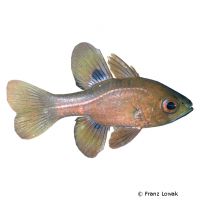Black Cardinalfish (Apogonichthyoides melas)
| Black Cardinalfish Apogonichthyoides melas | |
|---|---|
| Name | Black Cardinalfish |
| Name Lat. | Apogonichthyoides melas |
| Synonym | Apogon melas |
| Family | Cardinalfishes |
| Family lat. | Apogonidae |
| Order | Nurseryfishes |
| Order lat. | Kurtiformes |
| Origin | Western Pacific |
| Habitat | Protected bays |
| Diet | Carnivore |
| pH | 8.1-8.4 |
| Hardness | 8-10 °KH |
| Behavior | Peaceful |
| Keeping | Pair, group |
| Reef Compatible | Yes |
| Care Level | Moderate |
| Life Span | N/A |
| Protection | No |
| Metric Units | |
| Size | 8 cm |
| Temperature | 22-28 °C |
| Salinity | 33-36 ‰ |
| Aquarium | ~ 200 l |
| US Units | |
| Size | 3" |
| Temperature | 72-82 °F |
| Salinity | 1.020-1.025 sg |
| Aquarium | ~ 50 gal |
Distribution and habitat
The distribution area of Apogon melas is the Western Pacific, from Malaysia over the Moluccas to the Ryukyu Islands and New Caledonia. They live in the shallow waters of protected bays and lagoons with coral cover.
Maintenance
They require a well-structured aquarium with swimming space and a reef structure that offers hiding, resting and covering possibilities, with living stones that act like a biological filter as well as fine-grained sand surfaces. Only lime-rich, heavy metal-free sands, gravels, stones or sea sand of various grain sizes may be used as substrate
Filters, skimmers and heaters are necessary to ensure water quality, as well as pumps to simulate tides, swells and bottom currents. Lighting must correspond to the species-appropriate day-night rhythm of the animals
| Salinity: 33-36 ‰ | pH value: 8.1-8.4 |
| Carbonate hardness: 8-10 °KH | Nitrate content: 2-8 mg/l |
| phosphate content: 0.01-0.1 mg/l | nitrite content: 0.0-0.05 mg/l |
For salinity, an average value should be aimed for, which may only vary slightly by +/- 0.5 ‰. Ammonia and ammonium must not be measurable. Special attention must be paid to consistently good water quality and water values.
Diet
They are crepuscular lurkers that eat mainly planktonic small crustaceans, larvae and small fish. The change of feed is unproblematic. The food supply should consist of a combination of cyclops, artemia, mysis and krill, as well as live food fish for adults, plus chopped fish, mussel and shrimp meat or a frozen food mixture enriched with vitamins. Flake and granulated food is also usually well accepted. It is recommended to feed small portions several times during the twilight phase
Regular and varied feeding promotes health and increases resistance.
Behaviour and compatibility
It is recommended to maintain them in a group. Within the group there is a strict hierarchy. To avoid ranking fights, they should be placed in the aquarium at the same time, which must offer many hiding places. They usually behave peacefully towards other fish.
Sex dimorphism
They are protogynous hermaphrodites, meaning that most males develop from functional females when needed, and are referred to as "secondary males." The dominant, usually slightly larger animal always has male status. External sexual characteristics are not known.
Reproduction and breeding
They are mouthbrooders with intensive spawning care. There are no known reports about breeding in the aquarium.
Important
They rarely swim in open water during the day, but hide among branching stony corals. As reef dwellers, they should be kept with corals and not in a fish-only aquarium.
If different species are kept together, care should be taken to ensure that the fish match each other in terms of water quality and temperature requirements and social behavior, and that the setup meets the needs of all species kept together. New fish to be introduced must be acclimated slowly to the water in the aquarium
Further literature can be found in your pet store.
References
Text: Werner Winter; Image: Franz Lowak
Source: BAENSCH & PATZNER (1998): Meerwasser Atlas Bd. 7, Mergus Verlag; ENGELMANN (2005): Zootierhaltung - Tiere in menschlicher Obhut: Fische, Verlag Harri Deutsch
- Gemäß § 21 Abs. 5 Tierschutzgesetz idgF
